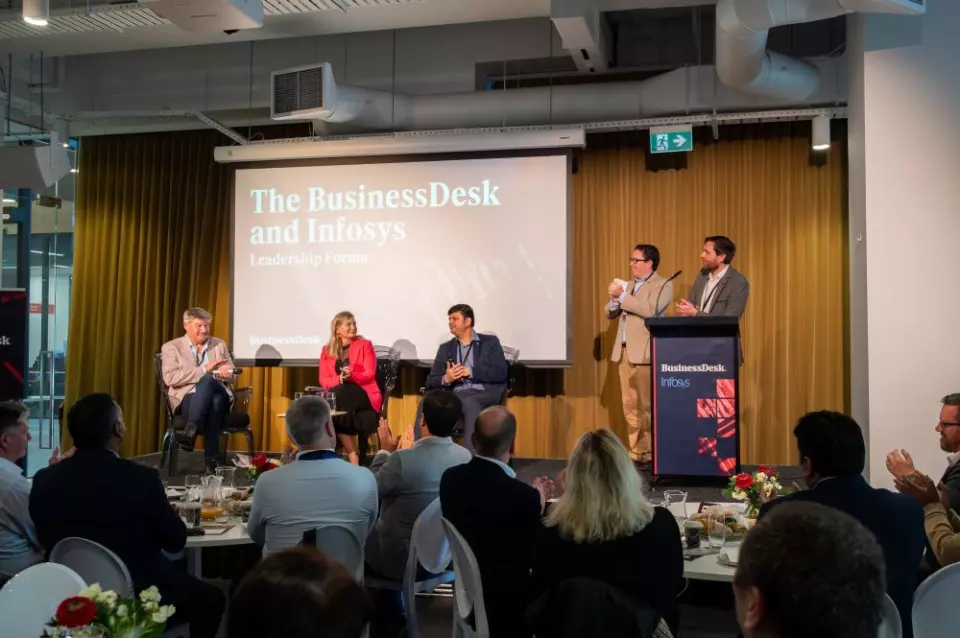As organisations strive to do more with less, they are turning to cloud and AI technologies to help them build back stronger.
We are barely 10 months into the generative AI revolution that kicked off with the debut of ChatGPT. But many of Aotearoa’s top companies are well advanced in developing or deploying Gen AI systems.
While AI has been playing a growing role in the enterprise over the last decade, the potential of large language models (LLMs) to power AI systems that automate mundane tasks and reinvent customer service, has quickly been seized upon all over the world.
For global IT services provider Infosys, the Gen AI revolution has accelerated the company’s focus on AI. It is in the process of upskilling 40,000 of its employees with Gen AI skills as it gears up to help customers deploy the technology.
“Infosys itself is aiming to be an AI-first enterprise,” Raja Shah, Senior Vice President, Infosys, and Industry Head, Global Markets, told the inaugural Business Desk and Infosys Leadership Forum in Auckland earlier this month.
“It’s a great enabler to amplify human potential, for the larger cause and create opportunities for people, businesses and communities.. It’s going to fundamentally transform the workplace as well as the workforce,” Shah added.
Watch more of Raja Shah on the Infosys Panel:
Infosys Topaz - the AI-first offering from Infosys
Infosys already has 80 Gen AI projects in the works and has launched Infosys Topaz, an AI-first set of services, solutions and platforms that feature 150+ pre-trained AI models and 10+ AI platforms to make the most of generative AI.
Shah said Infosys was taking a “phased approach” to incorporating Gen AI into its product offerings, making them “responsible by design”.
That focus on ethical AI is also common to the world’s largest software company Microsoft, which has reimagined everything from the Bing search engine to its Azure cloud platform by drawing on its own LLMs and those of its partner OpenAI, the company behind ChatGPT.
“It’s not often in your life you realise you are in the barrel of the wave, where you can see the future,” Vanessa Sorenson, Microsoft’s Global Partner Solutions Director for ANZ, and Managing Director, Microsoft New Zealand, told the forum of around 40 globally-focused chief executives, entrepreneurs and technology experts.
“[AI] will be infused in everything we do. In fact it has been for many years. It’s just now that we have the compute power to actually deliver all of the data,” Sorenson said.
Microsoft is in the process of introducing its AI-powered Copilot across its product line-up, including Microsoft 365, the productivity suite used by hundreds of millions of people around the world.
Putting a price on productivity
Sorenson said the service will be offered at a premium to existing Microsoft 365 licences, but that the productivity gains from having a digital assistant using AI to summarise information in the likes of Word, Teams, and Excel, will justify the price of admission.
“Those insights, I don’t know if I can put a price on it. How are you going to use these tools to think about new opportunities and spinning up new businesses? For us at Microsoft, it’s going to be continuous layering of value.”
Sorenson pointed to the current deployment of Github Copilot, an AI tool from Microsoft that is helping software developers automate aspects of the coding process.
“I think of the developer community that used to spend millions on massive projects and now can turn out something in a week that would have taken years,” she said.
At telecommunications provider One New Zealand (formerly Vodafone), AI is being used both to develop new products and services, as well as to monitor and improve the company’s fixed line and mobile networks.
Tony Baird, One’s Chief Technology Officer, said the widespread use of Agile technology development has come into its own in the era of Gen AI, allowing organisations to experiment with the technology to see if it’s fit for purpose.
Agile AI deployment
“The big move indecent years have been to agile, CI/CD (continuous integration and continuous delivery) pipelines where you can actually prototype, do beta testing, trial, change, pivot, rather than the 9 - 12 month waterfall programme where its big bang, goes out into the market and either succeeds or fails,” Baird said.
Watch more of Tony Baird on the Infosys Panel:
One was piloting Gen AI in its customer contact centre platform to improve customer service, but also intended to use AI to completely reverse engineer and deploy software to replace an ageing middleware product that was no longer supported.
The next generation of mobile networks, or 6G, will employ AI to analyse a user’s needs and deploy appropriate network resources in real-time, Baird added.
As organisations navigate through a new age of digital disruption and uncertainty, cloud is central to enabling digital transformation, including the deployment of AI.
Shah said New Zealand businesses were settling on a multi cloud strategy to suit their needs, and considering four key factors in doing so - capability, compatibility, compliance, and cost.
“The overall journey is about a cloud-right approach, rather than just a cloud first approach,” he said.
Microsoft will bring its Azure region to New Zealand in 2024 offering access to its own data centre region locally for the first time. Sorenson said that will help power local development of AI applications.
Watch more of Vanessa Sorenson on the Infosys Panel:
Fear of missing out
“Think of the art of the possible,” she urged forum executives.
“There is a fear of missing out, in terms of not doing anything,” Shah said of the buzz around Gen AI that has only grown in intensity this year.
“Have an AI strategy, a phased approach,” he advised.
“Right up front there should be guardrails, making sure that the design is done responsibly across all dimensions of it.
“But we see huge potential for our clients to look at their customer experience, for hyper-personalisation, reimagining sales and marketing channels, and finding efficiencies and better productivity.”






